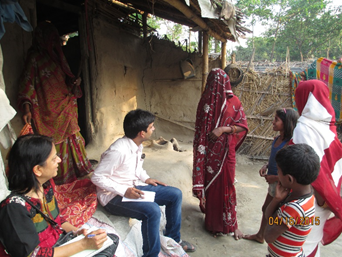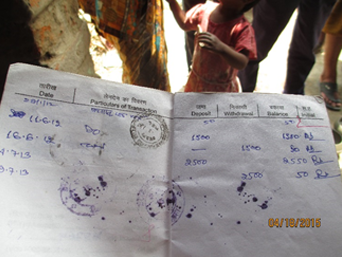Government of India’s maternity support programme – Pradhan Mantri Matru Vandana Yojana – seeks to provide income support to pregnant women and lactating mothers in rural India. Evaluating the programme in Bihar, this article finds that even though payments are delayed, the programme leads to significant improvement in the first child’s health. The likely channel is an increase in the interval between the first and second birth.
While doing fieldwork in Bihar in 2015, we were dismayed to find extensive delays – up to a year and more – in the receipt of payments for a maternity support programme intended to provide additional income to mothers during pregnancy and in the first six months after childbirth. It seemed to us that poor implementation would, once again, destroy any chance of programme effectiveness. Yet, our empirical analysis found significant effects on the target child (Ghosh and Kochar 2018). What explained this, and what can we learn from this result?
Evaluation of government’s maternity support programme in Bihar

The programme in question is India’s Pradhan Mantri Matru Vandana Yojana1 (PMMVY), a maternity support programme piloted in 2011 by the central government in 52 districts of the country. It has the potential to significantly improve maternal and child health (MCH) through income support to pregnant women and lactating mothers in rural areas, the vast majority of who do not work in formal markets and hence lose income if they curtail work hours during pregnancy. Studies show that this potential loss of income causes rural women to work throughout pregnancy and return to work almost immediately after, harming both their health and that of their newborn children (Sahayog, 2012). The government recognises the programme’s importance: it was amongst those mandated to be universally provided to all women under the National Food Security Act, 2013. Under current guidelines, each pregnant woman is to receive Rs. 6,000 (roughly equivalent to 50 days of full-time wage work in Bihar at the time) in two instalments, the second instalment being provided after evidence of the mother’s adherence to programme rules requiring health-improving practices such as pre- and postnatal care visits and immunisations.
The programme seemed doomed to failure in relatively backward regions, such as the northern state of Bihar, where we found that only 5% of eligible women received funds within the stipulated time period. This is despite the fact that payments are directly credited to women’s savings accounts, in the hope that doing so would reduce delays and enhance the programme’s effectiveness. If there was any effect on children at all, we thought that it would be on later-born children, since payments due for the first child generally came closer to the birth of the second child.
We evaluated the programme utilising its phasing and programme eligibility rules. It was implemented in only 52 of India’s districts, ranging from districts with poor MCH outcomes to those with good outcomes, as determined on the basis of a score constructed using national MCH statistics. We matched the two pilot districts (‘treatment’ districts where the programme was implemented) in Bihar, one relatively more advanced than the other, on the basis of this same score, selecting two ‘control’ districts (where the programme was not implemented) with practically the same score. Our ‘intent-to-treat’2 estimates compare eligible cohorts to ineligible cohorts across treatment and control districts, but, within eligible cohorts, also compare eligible to ineligible children exploiting the programme rule that provided income support only for children born in or after 2011, with the further restriction that support was available only for a mother’s first two children.
Positive impact on child health
Surprisingly, we found strong positive effects for the first eligible child on weight-for-age Z scores3 (WAZ), which compare the child’s weight to the World Health Organization’s (WHO) standards for children of the same age and gender. Since an extremely low percentage of eligible households received the income support around the time of the child’s birth, what could explain this effect?
One possibility was the health-enhancing conditions that women were supposed to adhere to in order to receive payments. Since prenatal visits had to be conducted during pregnancy, prior to disbursements of any payments, improvements in such health behaviours may have enhanced health, even though receipt of benefits was delayed. However, we found little effect of the programme on such behaviour, even among women who reported receiving payments. This reflects the inability of the State to enforce programme criterion, a shortcoming that applies equally to other related programmes. Women who received funds frequently were unable to produce Mother Child Protection (MCP) Cards, intended to be the means to verify adherence to the programme’s conditions. We were also able to rule out any spillover effects of heightened government attention to target districts, and hence to the functioning of other programmes. A final possibility is that the effect of income on the health of children varies with the child’s age, with larger effects on older children. If so, delayed payments may nevertheless improve the health of the (older) target child more than that of later-born younger children. However, our survey data also rejects this explanation.
We find, instead, that the programme significantly increased the interval between the first and the second birth. Building on a literature (Heckman and Walker 1990, DaVanzo, Hale, Razzaque and Rahman 2008) that examines the determinants of birth intervals, we interpret this as suggestive of an effect of expected income support on birth intervals. Knowledge of the programme was widespread among mothers in treatment villages, probably because every village in pilot districts had at least a few women who had received payments under the scheme. Credit-constrained parents will then bring forward the birth of their first child so as to sooner access promised support payments. And, delayed delivery of this payment may cause parents to put off the birth of their second child until the support for the first is received. These adjustments will increase the interval between the first and second births. Utilising eligibility as an instrument for birth intervals, we show that increases in the interval between the first and second child significantly improved the health of the first child.
Policy implications
There are several important implications of this finding. First, it suggests that dynamic fertility decisions, such as birth spacing, are important means of influencing child health. Though this is widely recognised, both in the academic literature as well as amongst policymakers, India’s flagship programme for MCH, the Integrated Child Development Service (ICDS) does not currently pay sufficient attention to counselling regarding birth intervals. Second, our results imply that households are unwilling to borrow against expected future income for expenditures that improve MCH, even when it is earmarked for pregnant women. This highlights the dependence of consumption on current income, and the critical need for improving policy implementation to ensure timely delivery of funds, particularly in programmes such as this.
In this regard, much is being made of the promise of the government’s expansion of financial inclusion to ensure bank accounts for every individual, and the direct payments to beneficiaries that this enables. All payments that were received did go directly to the mother’s savings account. However, this did not ensure timely payments. Additionally, it also did not help increase savings, which in turn could have helped ensure additional income at the time of subsequent pregnancies. Almost universally, households immediately removed the entirety of the payment when it was deposited to their accounts.

(A sample savings book transaction is shown in the image here). Even in the absence of maternity support programmes, significant improvements in MCH would be possible were households able to save to ensure income during pregnancy. This, however, would require not just improvements in financial literacy, but financial literacy programmes that combine with health programmes to stress the importance of planning for pregnancies and the periods of early childhood.
Our research findings are particularly useful as India debates the future of the programme. Under Prime Minister Modi, the scheme was renamed as PMMVY, and benefits were scaled back. The scheme now offers Rs. 5,000 during pregnancy and lactation for the first child only (Economic Survey 2017-18). The balance Rs. 1,000 comes from the Janani Suraksha Yojana (JSY), while in the past the income support under IGMSY was in addition to the payments under JSY. Media reports suggest that implementation of the scheme continues to be very poor.
Notes:
- The programme was earlier called Indira Gandhi Matritva Sahyog Yojana.
- Intent-to-treat effect is the difference in average outcomes between the treatment group (computed over all those that are assigned to the treatment group, irrespective of whether they actually receive the treatment/intervention or not) and the control group (computed over all assigned to the control group that are not meant to receive the treatment/intervention).
- Z score can be used to express the distance between an individual child's weight and the average weight of comparable children in the reference population. A z-score, or standard deviation, is a measure of the dispersion of data.
Further Reading
- DaVanzo, Julie, Lauren Hale, Abdur Razzaque, and Mizanur Rahman (2008), “The Effects of pregnancy spacing on infant and child mortality in Matlab, Bangladesh: How they vary by the type of pregnancy outcome that began the interval”, Population Studies 62(2):131-154.
- Ghosh, P and A Kochar (2016), ‘Income expectations and child health: Evidence from a maternity support programme in India’, International Growth Centre.
- Ghosh, Prabhat and Anjini Kochar (2018), “Do Welfare Programs Work in Weak States? Why? Evidence from a Maternity Support Program in India”, Journal of Development Economics 134: 191-208.
- Heckman, James J and James R Walker (1990), “The Relationship between Wages and Income and the Timing and Spacing of Births: Evidence from Swedish Longitudinal Data”, Econometrica, 58(6): 1411-1441.
- Sahayog (2012), ‘The Crisis of Maternity: Healthcare and Maternity Benefits for Women Wage Workers in the Informal Sector in India: A Compilation of Two National Studies’. Available at: https://aditigondal.files.wordpress.com/2012/08/the-crisis-of-maternity.pdf




 17 August, 2018
17 August, 2018 





Comments will be held for moderation. Your contact information will not be made public.